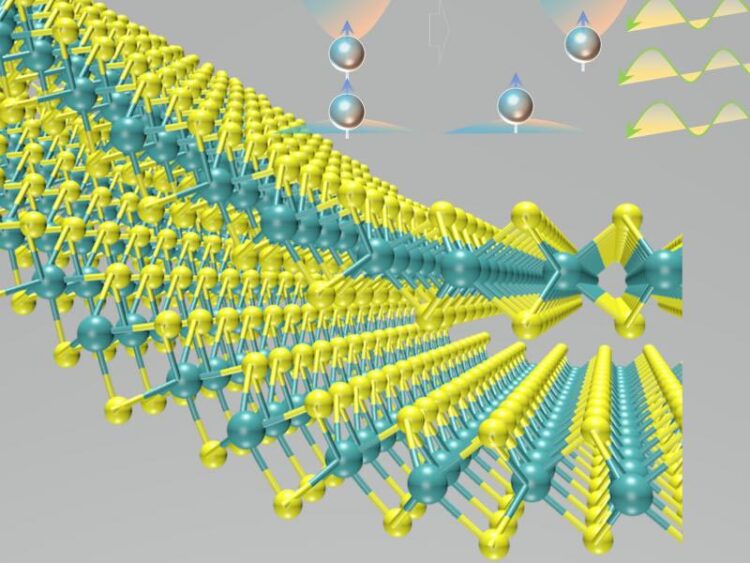Changing a 2D material’s symmetry can unlock its promise

Deforming MoS2 leads to the observation of the flexo-photovoltaic effect. Image credit: Jie Jiang, Jian Shi
Jian Shi Research Group engineers material into promising optoelectronic.
Optoelectronic materials that are capable of converting the energy of light into electricity, and electricity into light, have promising applications as light-emitting, energy-harvesting, and sensing technologies. However, devices made of these materials are often plagued by inefficiency, losing significant useful energy as heat. To break the current limits of efficiency, new principles of light-electricity conversion are needed.
For instance, many materials that exhibit efficient optoelectronic properties are constrained by inversion symmetry, a physical property that limits engineers’ control of electrons in the material and their options for designing novel or efficient devices. In research published today in Nature Nanotechnology, a team of materials scientists and engineers, led by Jian Shi, an associate professor of materials science and engineering at Rensselaer Polytechnic Institute, used a strain gradient in order to break that inversion symmetry, creating a novel optoelectronic phenomenon in the promising material molybdenum disulfide (MoS2) — for the first time.
To break the inversion symmetry, the team placed a vanadium oxide (VO2) wire underneath a sheet of MoS2. Molybdenum disulfide is a flexible material, Shi said, so it deformed its original shape to follow the curve of the VO2 wire, creating a gradient within its crystal lattice. Imagine what would happen if you placed a piece of paper over a pencil that was sitting on a table. The varied tension created in the paper is like the strain gradient formed in the MoS2 lattice.
That gradient, Shi said, breaks the material’s inversion symmetry and allows electrons traveling within the crystal to be manipulated. The unique photo-response observed near the strain gradient allows a current to flow through the material. It’s known as the flexo-photovoltaic effect, and it could be harnessed to design novel and/or high-efficiency optoelectronics.
“This is the first demonstration of such an effect in this material,” Shi said. “If we have a solution that does not create heat during photon-electricity conversion, then the electronic devices or circuits could be improved.”
Vanadium oxide is very sensitive to temperature, so the team was also able to demonstrate that the flexo-photovoltaic effect brought about temperature dependence at the site where the MoS2 and VO2 materials meet — changing the lattice’s gradient accordingly.
“This discovery suggests a novel principle that could be used for remote thermal sensing,” said Jie Jiang, a postdoctoral research fellow in Shi’s lab and the first author on this paper.
What the team was able to demonstrate here, Shi said, not only shows great promise for this material, but also suggests the potential of using such an approach in engineering other materials with favorable optoelectronic properties that are plagued by inversion symmetry.
###
About Rensselaer Polytechnic Institute
Founded in 1824, Rensselaer Polytechnic Institute is America’s first technological research university. Rensselaer encompasses five schools, 32 research centers, more than 145 academic programs, and a dynamic community made up of more than 7,600 students and over 100,000 living alumni. Rensselaer faculty and alumni include more than 145 National Academy members, six members of the National Inventors Hall of Fame, six National Medal of Technology winners, five National Medal of Science winners, and a Nobel Prize winner in Physics. With nearly 200 years of experience advancing scientific and technological knowledge, Rensselaer remains focused on addressing global challenges with a spirit of ingenuity and collaboration. To learn more, please visit http://www.
All latest news from the category: Materials Sciences
Materials management deals with the research, development, manufacturing and processing of raw and industrial materials. Key aspects here are biological and medical issues, which play an increasingly important role in this field.
innovations-report offers in-depth articles related to the development and application of materials and the structure and properties of new materials.
Newest articles

High-energy-density aqueous battery based on halogen multi-electron transfer
Traditional non-aqueous lithium-ion batteries have a high energy density, but their safety is compromised due to the flammable organic electrolytes they utilize. Aqueous batteries use water as the solvent for…

First-ever combined heart pump and pig kidney transplant
…gives new hope to patient with terminal illness. Surgeons at NYU Langone Health performed the first-ever combined mechanical heart pump and gene-edited pig kidney transplant surgery in a 54-year-old woman…

Biophysics: Testing how well biomarkers work
LMU researchers have developed a method to determine how reliably target proteins can be labeled using super-resolution fluorescence microscopy. Modern microscopy techniques make it possible to examine the inner workings…





















